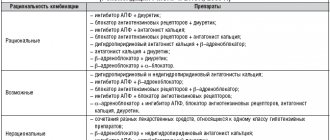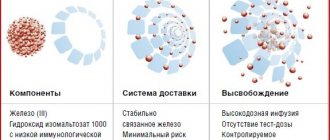Diuretics: what are they?
Diuretics are medications that speed up the formation of urine and its elimination from the body.
Such drugs are prescribed primarily to combat tissue swelling due to diseases of the cardiovascular system, kidneys and liver, as well as to treat severe pathological conditions that require rapid fluid reduction.
All diuretics differ in the mechanism of their diuretic effect. The pharmacological property of the drugs is their effect on the epithelium of the renal tubules, where urine formation occurs.
In addition, some medications affect certain enzymes and hormonal substances that are responsible for normal kidney function.
What causes swelling in the visual area?
In the area under the eyes there are fiber and fatty structures that easily retain moisture, so when the water balance in the body is disturbed, swelling occurs under the eyes. The causes of swelling can be different:
- excessive consumption of salty foods;
- ophthalmological diseases that are accompanied by inflammation;
- alcohol abuse;
- allergy;
- visual strain;
- diseases of the kidneys and other internal organs;
- violation of lymph outflow;
- oncopathology;
- congenital anomalies of the eyelids;
- traumatic injuries in the area of the visual organs.
If the cause of the swelling is not pathological, then, as a rule, it goes away within a few days without drug intervention. If swelling persists longer and becomes more pronounced over time, we can talk about a chronic process, which is most likely caused by some kind of disease. Having made an accurate diagnosis, the doctor will prescribe treatment, which most often involves taking diuretics - medications that help remove excess moisture from the body.
Indications for diuretics
The main indications for taking diuretics are the following conditions:
- Elimination of swelling of cells and tissues as a result of varying degrees of heart failure and vascular diseases.
- Kidney pathologies.
- Normalization of high blood pressure.
- Removal of toxic and other harmful substances from the body due to poisoning.
- Ascites.
- Liver cirrhosis.
- Glaucoma.
- Osteoporosis.
Edema is the main symptom of pathological conditions of the heart, blood vessels and dysfunction of the excretory system. Fluid accumulation is associated with retention of high amounts of sodium. The mechanism of action of diuretics is precisely that it removes sodium from the body, thereby eliminating swelling.
At high blood pressure levels, increased sodium content negatively affects the tone of blood vessels, leading to their narrowing. Therefore, taking diuretics removes this element from the body, increasing the lumen of blood vessels and normalizing blood pressure.
Due to poisoning, a certain amount of toxins and harmful compounds is reduced during kidney function. However, in order to speed up their elimination, patients are necessarily prescribed diuretics. First, patients are given an intravenous infusion of medicinal solutions, and then diuretics are administered, which, together with the liquid, eliminate toxic substances from the body.
Characteristics of edema of renal origin
Diseases of the urinary system are accompanied by edema with the following features:
- rapid swelling - in less than a day;
- the greatest intensity is on the face, under the eyes, on the arms and legs, and on the abdominal wall;
- when changing posture and active movement, the fluid shifts;
- the surface of the edematous skin is soft and pale.
Swelling of renal origin first appears on the face in the morning, but in acute pathologies and advanced chronic stages the patient may suffer from swelling around the clock.
Contraindications of drugs
The use of diuretics is not always advisable. There are certain conditions that prohibit the use of this type of medicine. These include:
- Low potassium levels in the blood.
- Individual intolerance to sulfonamide substances.
- Severe form of respiratory failure.
- Acute kidney diseases.
- Any type of diabetes.
An implicit contraindication to taking diuretics is ventricular arrhythmia. This clinical condition requires adjustment of the therapeutic dose and strict medical supervision.
How to distinguish cardiac edema from renal edema
Swelling in diseases of the heart and blood vessels develops slowly - from several weeks to 2-3 months. Especially noticeable in the evening. First it appears on the legs and lower abdomen, the next stage is swelling of the abdominal cavity and enlargement of the liver, noticeable upon palpation of the abdomen.
Renal edema is typically localized on the face; as the disease progresses, it spreads to the extremities. The contour of the face sags and shifts, the skin becomes loose, and under the eyes it becomes bluish. The liver is not enlarged. Reliable differential diagnosis can only be carried out by a qualified doctor during an examination.
Diuretic tablets for edema
To combat swelling, the most effective drugs are:
- Lasix is a loop diuretic that prevents sodium and chlorine retention.
- Britomar is available in the form of tablets for oral administration. Has long-term therapeutic activity.
- Diuver is a loop diuretic medicine. Often prescribed for heart failure and severe edema.
All medications have contraindications, so they must be taken as prescribed by a specialist.
Pathogenesis of renal edema
The mechanism of formation of renal edema is associated with the following phenomena in nephrological patients:
- massive loss of protein in urine;
- decrease in plasma albumin concentration;
- hyperlimidemia;
- increased movement of fluid from the intravascular space.
Patients have a high ratio of sodium and potassium in the urine, which indicates an imbalance of water and electrolyte balance.
The mechanism for the appearance of such a symptom is still not fully understood, but the characteristic picture indicates to the doctor pyelonephritis, glomerulonephritis. Filtration and excretion of urine are also impaired with kidney cysts, benign or malignant neoplasms.
Diuretic pills for weight loss
Taking diuretics has a positive effect on weight loss. This is due to a decrease in excess fluid in the body, acceleration of metabolism and a decrease in appetite. However, you should take medications carefully to avoid side effects. Therefore, you should consult your doctor first.
List of effective diuretics for weight loss:
- Furosemide.
- Hypothiazide.
- Veroshpiron.
- Phytonephrol.
- Phytolysin.
Commonly Prescribed Diuretics
The list of diuretics presented is incomplete, but it includes tablets that are often prescribed for swelling of the eyes. It is important to understand that the use of any of these medications is permissible only after consultation with a doctor.
"Furosemide".
A powerful prescription drug. For edema it acts very quickly, but has an impressive list of side effects.
"Veroshpiron".
Its speed of action is slower than that of furosemide, but it is also considered an effective drug for quickly relieving edema.
The best diuretics for swelling of the eyelids: a complete collection
04.11.2018
Puffy eyes can seriously ruin the appearance of your face. It is important to determine the cause of a symptom before starting medication. Diuretics for swollen eyes remove not only excess fluid from the tissues, but also important salts.
Causes of swelling
Fluid is retained in the body for various reasons. Sometimes the swelling can be short-lived, and sometimes it recurs regularly. The frequent appearance of edema for no apparent reason should force you to go to the clinic for examination.
The following reasons can cause excessive fluid accumulation in the eye area:
- excess salted, canned, smoked, spicy, fatty foods;
- drinking plenty of fluids at night;
- alcohol abuse;
- overstrain of the organ of vision;
- inflammatory eye diseases (conjunctivitis, blepharitis);
- kidney diseases (glomerulonephritis, amyloidosis, pyelonephritis);
- pathologies of the cardiovascular system (cardiomyopathies, heart failure);
- thyroid disease (hormone deficiency);
- cold;
- diseases of the ENT organs;
- allergy;
- traumatic damage to the organ of vision, burn;
- condition after surgery, cosmetic procedures;
- problems with venous outflow, lymph outflow;
- oncology.
Medicines
All diuretics have contraindications and side effects. Therefore, tablets with a diuretic effect against swelling under the eyes are allowed to be taken only after seeing a doctor. Be sure to eat dairy products, bananas, baked potatoes, raw cabbage, and garlic to replenish microelements.
Diuretic tablets for swelling of the eyes differ in the different speed of onset of effect.
- Fast-acting: Furosemide, Torasemide, Lasix, Triampur. The effect occurs after 1 hour. Used only as prescribed by a doctor.
- Slower effect: “Hydrochlorothiazide”, “Diacarb”, “Indapamide”, “Clopamide”. The effect occurs 2–4 hours after administration.
- Slow-acting: Veroshpiron, Spironolactone, Arifon. The effect occurs within a few hours and lasts for a long time.
The most popular for edema are “Veroshpiron” and “Torasemide”. These drugs do not remove important trace elements, therefore they are considered relatively safe diuretics for edema. It is allowed to take “Veroshpiron” for swelling of the eyes, 1 tablet per day, like other diuretic drugs from the second and third groups. Tablets from the first group are prescribed in half, 1 time per day.
This dosage is recommended specifically against swelling under the eyes. For the treatment of diseases of internal organs, drugs are prescribed according to other regimens.
Herbal diuretics include the drug "Canephron", it is effective against swelling under the eyes, and is approved for use in pregnant and lactating women. Recommended dosage: 50 drops 3 times a day or 2 tablets 3 times a day.
Folk recipes
Some products will help you remove excess water easily and without consequences. They need to be added to your diet. They are a mild diuretic, effective at home for swollen eyes. Products with a diuretic effect include:
- greens (parsley, celery);
- watermelon melon;
- grape;
- lemon;
- berries (rose hips, black currants, lingonberries, cranberries, raspberries, blueberries);
- onion garlic;
- pumpkin;
- dairy products.
Herbal teas
Diuretic herbs that help with puffiness under the eyes, such as bearberry and lingonberry leaf. Methods for preparing herbal tea:
- Bearberry. Brew 1 tsp. bearberry leaves in 200 ml of boiling water, let it brew. For taste, you can add a little black or green tea. Take 3 tbsp before meals. l. 3 times a day
- Lingonberry leaf. Pour in 1 tsp. lingonberry leaf with a glass of boiling water. Take no more than 4 glasses of diuretic tea per day.
- Shepherd's purse. The grass is poured with boiling water. After infusion, take 1 glass 3 times a day.
How to get rid of “bags” under the eyes using cosmetology?
It is faster and more expedient to remove pronounced fatty hernias of the lower eyelids if they have been present for a long time, as well as with excess stretched sagging skin and wrinkles (folds). Even several sessions with a cosmetologist may not lead to the desired aesthetic result. However, if puffy or fatty “bags” and “circles” under the eyes have been bothering you not so long ago, as well as the first signs of age-related skin changes (wrinkles, loss of tone), then you can fight them in the cosmetologist’s office. Let's talk about the most effective methods.
Injection cosmetology - MesoEye C71
What problems does it solve?
- Copes with persistent swelling;
- Removes noticeable “bags” (hernias) under the eyes, including eye bags;
- Removes dark circles;
- Removes wrinkles, including crow's feet;
- Noticeably refreshes a “tired look”;
- Effectively fights signs of age-related skin changes.
How many procedures will be required?
On average, 4-6. The result is visible after the first procedure.
Rehabilitation
Depends on skin sensitivity. Injections in the delicate and sensitive periorbital area, of course, cannot be called pleasant, but the micropapular technique allows you to not be a red panda after just 1 day 
Lymphatic drainage massage
What problems does it solve?
- Removes lymph and excess fluid, thus relieving swelling;
- Strengthens the skin around the eyes, enriching it with oxygen and stimulating the production of its own collagen and elastin;
- Smoothes out wrinkles;
- Returns tone to sagging skin.
How many procedures will be required?
A lasting and pronounced effect requires more than 4 procedures. Can be combined with home eye care.
Rehabilitation
No
Home care Follement Professionnel (France)
What problems does it solve?
- Noticeably reduces swelling under the eyes, has a drainage effect;
- Normalizes water balance;
- Prevents skin aging;
- Reduces the number of wrinkles and makes them less pronounced;
- Fights dark circles under the eyes;
- Fights signs of age-related skin changes, improves its tone.
How many procedures will be required?
Products from the Follement Professionnel line are recommended as additional regular skin care at home. Best combined with lymphatic drainage, microcurrent, or if you discuss this problem with a doctor. However, if puffy “bags” and dark circles under the eyes are not very pronounced, then you may be satisfied with the effect without procedures. Cosmetics contain special active ingredients. 78% of women and men note a visible effect after 1 month of use.
Rehabilitation
No
In our clinic you can consult with both a cosmetologist and a plastic surgeon (free of charge and even online). The doctor will select an individual option for facial beauty or an effective home care product with active ingredients. You can also purchase them in our clinic. And don’t forget to look at our website in the “promotions” section.
Microcurrent therapy
What problems does it solve?
- Remove dark circles under the eyes;
- Noticeably tightens the skin around the eyes, increases tone;
- Activate the production of their own collagen and elastin;
- Reduce the volume of subcutaneous fat - hernias at an early stage;
- Remove swelling;
- Returns skin tone.
How many procedures will be required?
The number of procedures is individual, on average 5-6 sessions. Can be combined with additional home care for the skin around the eyes.
Rehabilitation
No
Contour plastic surgery (filling) of the nasolacrimal groove with fillers
What problems does it solve?
- Allows you to fill the nasolacrimal groove and visually smooth the surface of the skin around the eyes;
- Reduce dark circles under the eyes;
- Smooth out small wrinkles;
- They improve skin quality and promote rejuvenation, since the main component is hyaluronic acid.
.
How many procedures will be required?
Depending on the drug and the individual characteristics of the skin, the effect lasts for a period of 6-12 months.
Rehabilitation
Like mesotherapy, it depends on the sensitivity of the skin. For 7 days, you need to protect your skin from heat and ultraviolet radiation, and follow the cosmetologist’s recommendations for the use of decorative cosmetics.
Laser resurfacing Deka SmartXide (non-surgical blepharoplasty)
What problems does it solve?
- Marked rejuvenation of the skin of the periorbital area - the skin of the eyelids tightens, becomes toned and elastic at the cellular level;
- Makes the nasolacrimal groove less pronounced, visually removing “bags” under the eyes (but not fatty hernias);
- Evens out skin texture, smoothes out fine wrinkles;
- Promotes rapid skin regeneration;
- Noticeably refreshes the look.
How many procedures will be required?
Depending on the scale of the problem, approximately 2-4 sessions. However, after the first grinding, the result will pleasantly surprise you.
Rehabilitation
7 days









